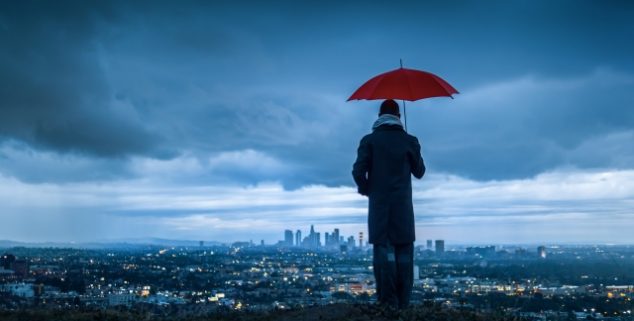News
Drought’s back broken — or not?
 A man shielded against the rain looks across L.A. from the Hollywood Hills. (Photo: Shutterstock)
A man shielded against the rain looks across L.A. from the Hollywood Hills. (Photo: Shutterstock)Despite the torrential rains of the last few weeks, experts say it’s too early to tell whether California’s interminable drought is really over. It will be necessary to monitor rainfall through at least March to make an assessment.
California has been in a drought since 2012. Gov. Jerry Brown declared a drought state of emergency in January 2014 after the state experienced record dry conditions.
The best scenario is a good snow pack that melts slowly in the spring providing ample supply in the summer.
Jennifer Bowles, executive director of the Water Education Foundation, said before the recent series of storms that 82 percent of the state was still affected by the drought and half was still in a severe drought.
“We still have a while to dig ourselves out,” she said earlier this month.
Since then, reservoirs have started to fill, the Sierra snowpack has grown and the outlook is brighter.
Unfortunately, the state isn’t able to use all the rainfall that comes down.
“When we get rain, the rain comes rushing down the mountains and sometimes it fills up the reservoir too much and they have to let it go to the ocean to avoid flooding,” Bowles said.
The best scenario is a good snow pack that melts slowly in the spring providing ample supply in the summer, she said.
Californians should keep conserving water. As examples, they should make sure they turn off their automatic irrigation systems when it rains and hold off on washing their cars. Such small measures add up and make a difference.
Conditions are still bad in Tulare County, where the state is providing emergency water supplies because of dried up wells.
Assemblyman Eduardo Garcia, D-Coachella, chairman of the assembly committee on water, parks and wildlife, agreed that water conservation measures are still necessary. It’s always a good idea to save water during the state’s wet years because dry years will inevitably come again. “These practices should become the normal way of life,” he said.
The staff of the State Water Resources Control Board agrees, at least in part: It recommended this week that the current rules targeting the drought stay in effect for at least another three months.
Whether there is a drought or not depends more on how different areas of the state are affected than how much rainfall there is. “Drought is a function of impacts,” said Janine Jones, interstate resources manager for the state department of water resources. “Some areas will continue to experience those impacts for a while. California is a big state. Different areas will have different conditions.”
For instance, conditions are still bad in Tulare County, where the state is providing emergency water supplies because of dried up wells.
Jones said she understands that it’s confusing to the public to hear about floods and drought at the same time but that’s the nature of living in California. “We tend to go from one extreme condition to the other pretty rapidly,” she said.
“If the tunnel project went through, a lot more water would be safe.” — Jeffrey Kightlinger.
Jeffrey Kightlinger, general manager of The Metropolitan Water District of Southern California, said he is optimistic that the drought will be over, though he agrees that it is too soon to tell for sure. “Certainly, the drought emergency is over,” he said.
These past big rains are helping fill up reservoirs in Oroville, Shasta and San Luis but it’s hard to get that water moving from north to south, he said. Kightlinger said that is the reason for the governor’s proposed California Water Fix, which would build two large tunnels to carry fresh water from the Sacramento River under the Sacramento-San Joaquin Delta to intake stations for the State Water Project and California Valley Project- the state’s biggest water systems. “If the tunnel project went through, a lot more water would be safe,” Kightlinger said.
The goal is to move more water down south during rainy season when rivers are high and then take less in the summer, leaving more water for fish and other species. With climate change, this is going to be more of an issue, Kightlinger said
“We’re going to get huge storm events like this on a more regular basis but we won’t have a nice snow pack that melts in June, July and August. We have to move as much water as we can in the winter.”
—
Ed’s Note: Includes time element in 3rd, 4th grafs.
Want to see more stories like this? Sign up for The Roundup, the free daily newsletter about California politics from the editors of Capitol Weekly. Stay up to date on the news you need to know.
Sign up below, then look for a confirmation email in your inbox.

Our state has a very large, diverse and impressive environment from the north to the south. Sometimes the heaviness of one segment can take out ALL of the air leaving no a biased direction. The environmental bigness in California has used legislation and manipulated laws to strangle dynamic opportunities, Allow more state sectors on the dias. Sustainability is not protecting ones pension, instead it’s an semi-equality balance of Econonmical, Environmental and Social movements. Do Well for Citizens all.